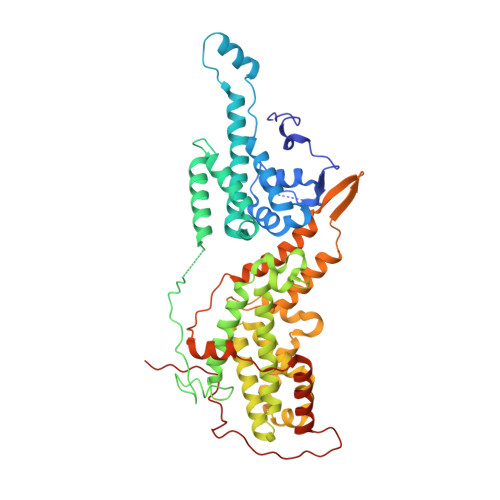High-throughput screening identifies small molecules that bind to the RAS:SOS:RAS complex and perturb RAS signaling.
Burns, M.C., Howes, J.E., Sun, Q., Little, A.J., Camper, D.V., Abbott, J.R., Phan, J., Lee, T., Waterson, A.G., Rossanese, O.W., Fesik, S.W.(2018) Anal Biochem 548: 44-52
- PubMed: 29444450
- DOI: https://doi.org/10.1016/j.ab.2018.01.025
- Primary Citation of Related Structures:
5WFO, 5WFP, 5WFQ, 5WFR - PubMed Abstract:
K-RAS is mutated in approximately 30% of human cancers, resulting in increased RAS signaling and tumor growth. Thus, RAS is a highly validated therapeutic target, especially in tumors of the pancreas, lung and colon. Although directly targeting RAS has proven to be challenging, it may be possible to target other proteins involved in RAS signaling, such as the guanine nucleotide exchange factor Son of Sevenless (SOS). We have previously reported on the discovery of small molecules that bind to SOS1, activate SOS-mediated nucleotide exchange on RAS, and paradoxically inhibit ERK phosphorylation (Burns et al., PNAS, 2014). Here, we describe the discovery of additional, structurally diverse small molecules that also bind to SOS1 in the same pocket and elicit similar biological effects. We tested >160,000 compounds in a fluorescence-based assay to assess their effects on SOS-mediated nucleotide exchange. X-Ray structures revealed that these small molecules bind to the CDC25 domain of SOS1. Compounds that elicited high levels of nucleotide exchange activity in vitro increased RAS-GTP levels in cells, and inhibited phospho ERK levels at higher treatment concentrations. The identification of structurally diverse SOS1 binding ligands may assist in the discovery of new molecules designed to target RAS-driven tumors.
Organizational Affiliation:
Vanderbilt University School of Medicine, Department of Biochemistry, 2215 Garland Ave., 607 Light Hall, Nashville, TN, 37232-0146, USA.


















